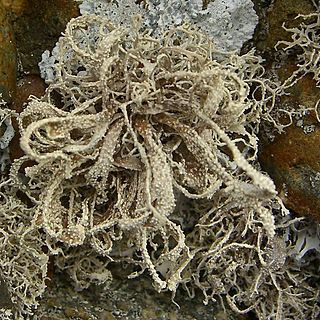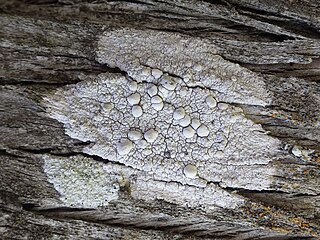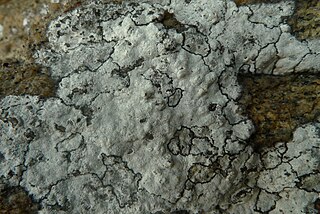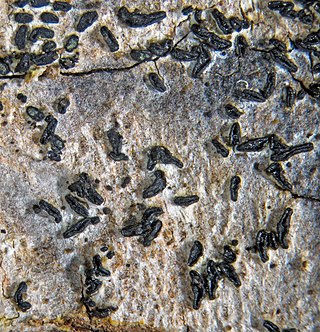
The Arthoniales is the second largest order of mainly crustose lichens, but fruticose lichens are present as well. The order contains around 1500 species, while the largest order with lichenized fungi, the Lecanorales, contains more than 14000 species.

The Arthoniaceae are a family of lichenized, lichenicolous and saprobic fungi in the order Arthoniales. The Arthoniaceae is the largest family of Arthoniales, with around 800 species. Most species in Arthoniaceae belong in Arthonia which is the largest genus with 500 species. The second and third largest genus is Arthothelium with 80 species, and Cryptothecia with 60 species.

The Roccellaceae are a family of fungi in the order Arthoniomycetes. Most taxa are lichenized with green algae, although some are lichenicolous, growing on other lichens.

Dendrographa is a genus of lichen-forming fungi in the family Roccellaceae. It has seven species. It was given its current name by Otto Vernon Darbishire in 1895.

Dirina is a genus of lichen-forming fungi in the family Roccellaceae. All Dirina species are crustose lichens with a whitish to greyish brown thallus, and live either on rock or on bark–some species can live on both. The photobiont partner is a member of the green algal genus Trentepohlia. Most species occur in the Northern Hemisphere, and are generally restricted to coastal habitats, where they may be locally quite common. Erythrin and lecanoric acid are lichen products that usually occur in Dirina species, along with several other unidentified substances.

Lecanographa is a genus of about 40 species of lichens in the family Lecanographaceae. It was circumscribed in 1994 by José M. Egea and Pilar Torrente, with Lecanographa lyncea as the type species.

Lecanactis is a genus of crustose lichens, commonly called old wood rimmed lichen. The genus was circumscribed in 1855 by German lichenologist Gustav Wilhelm Körber, who assigned Lecanactis abietina as the type species.

Roccellographa is a genus of lichen-forming fungi in the family Roccellographaceae. The genus was circumscribed by Austrian lichenologist Julius Steiner in 1902, with Roccellographa cretacea assigned as the type, and at that time, the only species. Three additional species have since been transferred to the genus from other genera.

Syncesia is a genus of lichen-forming fungi in the family Roccellaceae.

Alyxoria is a genus of lichen-forming fungi in the family Lecanographaceae.

Opegraphaceae is a family of lichen-forming and lichenicolous fungi in the order Arthoniales. It was originally proposed by German lichenologist Ernst Stizenberger in 1862. It fell into disuse, but was resurrected in a molecular phylogenetic study of the order Arthoniales published in 2010. It now includes taxa that were previously referred to the family Roccellaceae, its sister group.

Roccellographaceae is a family of lichen-forming fungi in the order Arthoniales. It contains three genera: Dimidiographa, Fulvophyton, and Roccellographa.
Vigneronia is a genus of lichen-forming fungi in the family Roccellaceae. It has five species. The genus was circumscribed in 2014 by Damien Ernst, with Vigneronia spieri assigned as the type species. This species, originally described as Schismatomma spieri from collections made in the Galápagos Islands, has since been recorded from mainland Ecuador and the Antilles (Curaçao). The genus is named after Ernst's wife, Nathalie Vigneron, who accompanied him on collecting trips.
Gyrographa is a genus of lichen-forming fungi in the family Roccellaceae. The genus was circumscribed in 2014 by Damien Ernst and Anders Tehler, with Gyrographa gyrocarpa assigned as the type species. This lichen, originally described by Julius von Flotow in 1825, was first placed in the genus Opegrapha. Species in the genus have a crustose thallus lacking a cortex, and a dark brown prothallus. The photobiont partner is trentepholioid. The hypothecium is thick and carbonised, and the ascospores lack a gelatinous sheath; these characteristics distinguish it from Opegrapha species. The genus name alludes to the gyrose ascomata of the type species.
Gyronactis is a genus of lichen-forming fungi in the family Roccellaceae. It has two species. The genus was circumscribed by Damien Ernst and Anders Tehler in 2014, with G. asiatica assigned as the type species. This lichen, formerly placed in Lecanactis, is only known from the type locality in Myanmar. The genus name alludes to both its similarity with Lecanactis and the presence of gyrophoric acid in the thallus.
Isalonactis is a monotypic fungal genus in the family Roccellaceae. It contains the single species Isalonactis madagascariensis, a saxicolous (rock-dwelling), crustose lichen found in Madagascar. Both the genus and species were described as new in 2014 by Damien Ertz, Anders Tehler, Eberhard Fischer, Dorothee Killmann, Tahina Razafindrahaja, and Emmanuël Sérusiaux. The type was collected on the Isalo Massif at an altitude of 851 m (2,792 ft); there, it was found growing on sheltered mesozoic sandstone cliffs. The genus name alludes to both Isalo Massif, the type locality, and the phylogenetic relatedness to genus Lecanactis.
Ocellomma is a genus of lichen-forming fungi in the family Roccellaceae. The genus was circumscribed in 2014 by Damien Ertz and Anders Tehler, following a molecular phylogenetic-based revision of the Roccellaceae. The type species, O. picconianum, was originally named Lecania picconiana by Francesco Baglietto in 1862, described from specimens collected in Italy. DNA-based phylogenetic analysis showed that it occupied a distinct genetic lineage, deserving of recognition as a new genus. The genus name Ocellomma alludes to the whitish rims on the small ascomata that contrast with the discs, giving them the appearance of small eyes.
Dimidiographa is a genus of lichen-forming fungi in the family Roccellographaceae. It has three species of crustose lichens, with Dimidiographa loandensis serving as the type species.
Fouragea is a genus of lichen-forming fungi in the family Opegraphaceae. It has nine species.

Fulvophyton is a genus of lichen-forming fungi in the family Roccellographaceae. It has 11 species. Fulvophyton is characterised by its crust-like thallus, which is often pale yellowish-brown in colour. This genus features a photobiont from the green algal genus Trentepohlia and exhibits a unique arrangement of reproductive structures.












